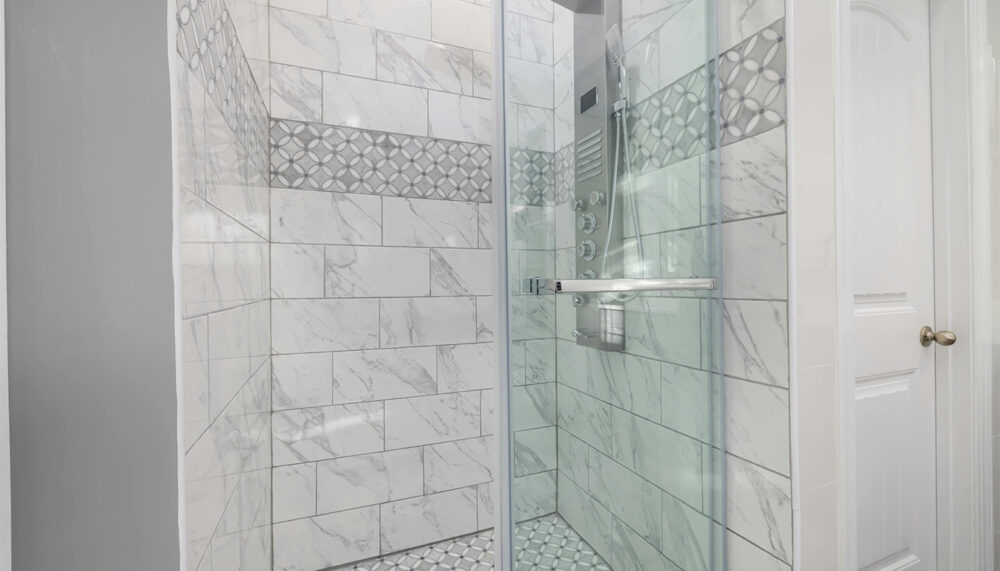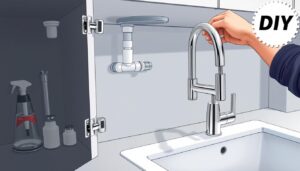A sparkling glass shower screen can make your bathroom feel fresh and inviting, but keeping it that way often feels like an uphill battle. Water spots, soap scum and limescale build-up can quickly dull its shine, leaving you wondering how to restore its pristine look. The good news? It’s easier than you think with the right approach.
Why Cleaning Glass Shower Screens Is Important
Maintaining clean glass shower screens prevents the build-up of dirt, soap scum, and hard water stains that can cause unsightly marks. Over time, these deposits can damage the surface and make cleaning more difficult. If you’re dealing with persistent limescale. Cleaning becomes especially important depending on the screen’s design. Learn how framed and frameless shower screens differ when it comes to maintenance and style.
Clean screens enhance the bathroom’s appearance, keeping it bright and inviting. Dirty glass can make even an otherwise clean space look unkempt.
Regular cleaning helps prolong the lifespan of the glass by preventing scratches and itching caused by stubborn mineral deposits. You also reduce the risk of mould and mildew growth, which thrive in humid environments.
Hygiene improves when grime and bacteria are removed from the glass surface. This creates a safer and more sanitary space for daily use.
Regular cleaning helps prolong the lifespan of the glass by preventing scratches and itching caused by stubborn mineral deposits. You also reduce the risk of mould and mildew growth, which thrive in humid environments. If left untreated, these can impact not just your bathroom but your health as well. The UK government’s guide on damp and mould outlines the risks and stresses the importance of prevention in domestic spaces.
Common Challenges With Glass Shower Screens
Maintaining a spotless glass shower screen can be difficult due to common issues like soap scum, water stains, and mould. These challenges impact both the appearance and hygiene of your bathroom.
Soap Scum And Hard Water Stains
Soap scum and hard water stains result from residue left behind by soapy water and mineral deposits. These marks often appear as cloudy patches or white streaks on the glass. Removing them can be time-consuming if they aren’t addressed promptly. Stubborn stains may require specific cleaning solutions, with acidic cleaners like white vinegar effective against mineral build-up.
Streaks And Smudges
Improper cleaning techniques or products often cause streaks and smudges, leaving the screen looking dull despite your efforts. Using cleaning cloths that leave fibres behind or inadequate rinsing can worsen the issue. Microfibre cloths and a squeegee reduce streaks and create a polished finish on the surface.
Mould And Mildew
Mould and mildew thrive in the damp environment of bathrooms, especially where water lingers on shower screens. These fungi not only stain the glass but also release unpleasant odours and pose health risks. Ensuring regular cleaning and ventilation reduces moisture build-up, minimising the likelihood of fungal growth on the screen. The NHS guide on damp and mould explains the health risks and offers advice on keeping your bathroom dry and safe.
Tools And Materials Needed
Using the right tools and materials simplifies cleaning your glass shower screen effectively. Gathering these essentials ensures optimal results without causing damage.
Cleaning Products
Choose effective cleaning products to remove dirt, soap scum, and stains. White vinegar works well for tackling hard water marks due to its acidic properties. Use a mild dishwashing liquid to dissolve grease and soap residues. Baking soda, when combined with water, creates a gentle abrasive paste perfect for stubborn spots. Store-bought glass cleaners designed for shower screens ensure streak-free shine. Avoid harsh chemicals that could etch the glass or damage protective coatings.
Cloths, Scrubbers, And Tools
Select non-abrasive and efficient tools to maintain your shower screen’s clarity. Microfibre cloths are ideal for absorbing moisture and leaving surfaces streak-free. Use a squeegee for quick removal of water after every shower to prevent water spots. For tougher stains, soft-bristled scrub brushes or non-scratch sponges are effective. Keep a spray bottle handy for effortless application of cleaning solutions. Protective gloves help when using acidic or abrasive cleaners to safeguard your skin.
Step-By-Step Guide On How To Clean Glass Shower Screens
Follow this detailed guide to effectively clean your glass shower screen and restore its transparency. Proper techniques and materials help achieve optimal results without causing damage.
Preparing The Shower Screen
Remove loose dirt and rinse the screen with warm water to eliminate surface debris. Clear any personal items like soap dishes or bottles from the area to access the glass fully. Inspect the surface to identify areas with heavy stains or build-up for spot treatment.
Applying The Cleaning Solution
Use a spray bottle to apply a generous amount of white vinegar, diluted in equal parts with water, onto the glass. For stubborn stains or limescale, sprinkle baking soda over the wet surface after spraying. If using store-bought glass cleaners, ensure they’re designed for shower screens to avoid streaks.
Scrubbing And Rinsing
Use a soft scrub brush or a non-abrasive sponge to work the solution in circular motions over stubborn areas, while focusing on soap scum or water patches. Rinse thoroughly with warm water to remove all cleaning residue and prevent any film build-up on the glass.
Drying And Polishing
Wipe the glass dry using a microfiber cloth to prevent streaks after rinsing. For a polished finish, run a clean, dry squeegee over the surface to catch any remaining water droplets. Buff gently for clarity and shine.
Tips To Keep Glass Shower Screens Cleaner For Longer
Simple habits and preventive measures can help maintain your glass shower screen’s pristine condition. Implementing these strategies reduces cleaning frequency while preserving the screen’s shine.
Regular Maintenance Routine
Drying the glass after each use prevents water spots and soap scum build-up. Use a squeegee or microfibre cloth immediately after your shower to remove excess water. Pay particular attention to corners and edges.
Ventilation keeps the shower area dry, minimising humidity and discouraging mould. Open windows, use an exhaust fan, or leave the shower door slightly ajar.
Inspect the shower seal and frame for dirt accumulation weekly. Clean these areas gently to avoid hidden grime and moisture trapping.
Preventing Build-Up
Apply a water-repellent solution to keep glass cleaner for longer. These sprays create a protective barrier, repelling water, soap, and limescale. Reapply the solution every few weeks for sustained effectiveness.
Limit soap scum formation by switching to liquid soap or shower gel instead of bar soap, which leaves residue. Softening hard water with a water softener also reduces mineral deposits and stains.
Place a soft-bristled brush in your bathroom for quick scrubbing when you notice new stains or soap-scum accumulation. Addressing these early avoids tougher stains later.
Recommended Cleaning Schedules
Clean frequently for long-lasting results. Wipe the screen daily after showers to remove immediate water residue. Dedicate one cleaning per week to applying vinegar or a mild cleaner, followed by scrubbing any visible spots softly.
Schedule thorough cleaning monthly. Use a deeper cleaning method involving baking soda or store-bought glass cleaners to remove any persistent stains. Rinse and thoroughly dry for a streak-free finish.
Eco-Friendly Alternatives For Shower Screen Cleaning
Switching to eco-friendly cleaning solutions helps maintain a clean shower screen while reducing environmental impact. Several natural options work effectively without relying on harsh chemicals.
- White Vinegar Solution: Mix equal parts of white vinegar and warm water in a spray bottle. Spray it onto the screen and let it sit for 10–15 minutes before wiping with a microfibre cloth. Its acidity dissolves hard water stains and soap scum.
- Baking Soda Paste: Combine baking soda with water to create a thick paste. Spread it over stubborn spots, scrub gently with a soft-bristled brush, then rinse thoroughly. Baking soda is a mild abrasive that deep-cleans without scratching the glass.
- Lemon Juice Cleaner: Squeeze fresh lemon juice and mix with water in a 1:1 ratio. Apply it to the surface, let it sit for 5–10 minutes, and rinse with water. Lemon juice’s citric acid works as a natural degreaser and deodoriser.
- Eco-Friendly Dish Soap: Use an eco-labelled dishwashing liquid diluted with warm water. Apply the mixture using a non-abrasive sponge to lift grease and soap residue efficiently without adding pollutants to water systems.
- Cornstarch Polisher: Mix 1 tablespoon of cornstarch with a litre of water. Apply the solution using a damp microfiber cloth, polish in circular motions, and rinse for a streak-free shine. Cornstarch removes residue naturally.
Use plant-based or biodegradable products to minimise toxic runoff while keeping your bathroom surfaces spotless.
Conclusion
Maintaining a spotless glass shower screen doesn’t have to be a daunting task. With the right approach and a bit of consistency, you can keep your screen looking clear and hygienic while extending its lifespan. Small daily habits, eco-friendly solutions, and proper tools make all the difference in preserving its shine.
By staying proactive and addressing issues like soap scum and water stains early, you’ll save time and effort in the long run. A clean shower screen not only enhances your bathroom’s appearance but also creates a healthier and more pleasant environment for your daily routine.
Frequently Asked Questions
Why does my glass shower screen become dull over time?
Glass shower screens become dull due to water spots, soap scum, and limescale build-up from hard water minerals and residue. Improper cleaning and moisture in the bathroom also contribute to cloudiness and dirt accumulation.
What’s the best way to clean stubborn soap scum from the glass?
Use a mixture of white vinegar and water or a paste made with baking soda to tackle stubborn soap scum. Apply the solution, scrub gently with a soft-bristled brush or microfibre cloth, and rinse thoroughly for best results.
How often should I clean my glass shower screen?
Clean glass shower screens daily by wiping them dry with a squeegee or microfibre cloth. Perform a deeper cleaning weekly with mild cleaners and vinegar, and thoroughly clean monthly with baking soda or glass-specific cleaners.
Can I use harsh chemicals on my shower screen?
Avoid using harsh chemicals as they may damage the glass, weaken protective coatings, or cause etching. Instead, opt for natural cleaners like vinegar or eco-friendly products for a safer, streak-free finish.
How do I prevent water spots on my shower screen?
Dry the screen after every shower using a squeegee or microfibre cloth to prevent water spots. You can also apply a water-repellent solution to create a protective barrier against hard water deposits.
What tools are recommended for cleaning glass shower screens?
Use non-abrasive tools like microfibre cloths, squeegees, and soft scrub brushes. Protective gloves are also ideal for handling acidic cleaners like vinegar or baking soda mixtures.
Why is ventilation important for maintaining shower screens?
Good ventilation minimises moisture and reduces the risk of mould and mildew growth on glass shower screens. Open windows, use an exhaust fan, or keep the bathroom door slightly ajar after showering.
How do I remove mould from my glass shower screen?
Mix equal parts white vinegar and water, spray it on the mouldy area, and let it sit for 10-15 minutes. Scrub gently with a brush, rinse thoroughly, and dry the screen to avoid further mould growth.
Are there eco-friendly cleaning alternatives for shower screens?
Yes, you can clean your shower screen using natural options like white vinegar, a baking soda paste, lemon juice, or eco-friendly dish soap. These alternatives are effective and safe for the environment.
How can I make my shower screen stay cleaner for longer?
Wipe the screen dry daily, apply a water-repellent solution, and ensure proper ventilation. Switch to liquid soap to reduce soap scum and follow a regular cleaning schedule to maintain shine and cleanliness.






